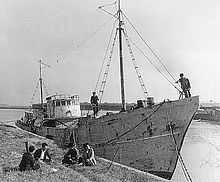Daigo Fukuryū Maru

Daigo Fukuryū Maru (第五福龍丸, Lucky Dragon 5) was a Japanese tuna fishing boat, which was exposed to and contaminated by nuclear fallout from the United States' Castle Bravo thermonuclear device test on Bikini Atoll, on March 1, 1954.
Kuboyama Aikichi, the boat's chief radioman, died less than seven months later, on September 23, 1954, suffering from acute radiation syndrome. He is considered the first victim of the hydrogen bomb of Operation Castle Bravo.
Early days
In 1947, the fishing boat was launched from Koza, Wakayama, named Dainana Kotoshiro Maru (第七事代丸, Kotoshiro Maru No. 7). Later it became a tuna fishing boat in Yaizu, Shizuoka, where it was renamed the Daigo Fukuryū Maru.
Nuclear test site contamination

Daigo Fukuryū Maru encountered the fallout from the U.S. Castle Bravo nuclear test on the Bikini Atoll, near the Marshall Islands, on March 1, 1954. The boat, along with its 23 fishermen aboard, as well as their catch of fish, was contaminated. They returned to Yaizu, Japan on March 14. The crew members, suffering from nausea, headache, burns, pains in the eyes, bleeding from the gums, etc., were diagnosed with acute radiation syndrome and admitted to two Tokyo hospitals. On September 23, chief radio operator Mr. Aikichi Kuboyama, 40, died — the first Japanese victim of a hydrogen bomb. He left these words: "I pray that I am the last victim of an atomic or hydrogen bomb."[1][2]
The sky on the west lit up like a sunrise. Eight minutes later the sound of the explosion arrived, with fallout several hours later. The fallout, fine white flaky dust of calcined coral with adsorbed highly radioactive fission products, fell on the ship for three hours. The fishermen scooped it to bags with their bare hands. The dust stuck to surfaces, bodies and hair; after the radiation sickness symptoms apeared, the fishermen called it shin no hai (死の灰, death ash). The US government refused to disclose its composition due to "national security", as the isotopic ratios, namely percentage of uranium-237, could reveal the nature of the bomb. Lewis Strauss, the head of the AEC, issued a series of denial; he went so far to claim the lesions on the fishermen bodies are not caused by radiation but by chemical action of the calcined coral, that they were inside the danger zone (while they were 40 miles away), and told the Eisenhower's press secretary that Lucky Dragon was a "Red spy outfit", commanded by a Soviet agent intentionally exposing the ship crew and catch to embarrass the USA and gain intelligence on the test. He also denied the extent of contamination of the fish catch by Fukuryu Maru and other ships. The FDA however imposed rigid restrictions on tuna imports.[3] The United States dispatched two medical scientists to Japan to limit the public disclosure and study the effects of fallout on the ship crew, under the pretense of helping with their treatment.[4][5] Even publications of the fallout analysis were a thorny political issue.[6]
When the test was held, the Daigo Fukuryū Maru was catching fish outside the danger zone which the U.S. government had declared in advance. However, the test was over twice as powerful as it was predicted to be, and changes in weather patterns blew nuclear fallout, in the form of a fine ash, outside of the danger zone.[2] The fishermen realized the danger, and attempted to escape from the area, but they took time to retrieve fishing gear from the sea, causing them to be exposed to radioactive fallout for several hours.
Later, the United States expanded the danger zone and it was revealed that in addition to the Daigo Fukuryū Maru, many other fishery boats were in the expanded zone at the time. It is estimated that about a hundred fishing boats were contaminated to some degree by fallout from the test. Many hundreds of inhabitants of the Marshall Islands were also exposed, and a number of islands had to be evacuated entirely.[2]
The US at first tried to cover up the Lucky Dragon incident, sequestering the victims and declaring the site off limits. Later the United States paid Kuboyama's widow and children the equivalent in yen of about $2,500.[7]
The tragedy of the Daigo Fukuryū Maru gave rise to a fierce anti-nuclear movement in Japan, rising especially from the fear that the contaminated fish had entered the market. It also inspired the entire Kaiju eiga (monster movies) starting with Godzilla (Gojira) in 1954. The U.S. government feared this movement would lead to an anti-American movement, and attempted to quickly negotiate a settlement with the Japanese government (led at the time by the Prime Minister Shigeru Yoshida, who was considered to be a pro-U.S. politician). The U.S. government agreed to pay $2 million compensation to the Japanese for injuries or damage sustained as a result of the blast.[8] The Japanese government also acknowledged that it would not pursue further reparations from the U.S. government.
The Daigo Fukuryū Maru was preserved in 1976 and is now on display in Tokyo at the Tokyo Metropolitan Daigo Fukuryū Maru Exhibition Hall.[9]
See also
- History of nuclear weapons
- Project 4.1 — study of other victims of Bravo contamination
External links
- Official website of the Tokyo Metropolitan Daigo Fukuryū Maru Exhibition Hall. Japanese
- Daigo Fukuryū Maru Exhibit at the Official Homepage of the Hiroshima Peace Memorial Museum
- Daigo Fukuryu-Maru (1959) - IMDB film entry
Notes and references
- ^ http://search.japantimes.co.jp/mail/ed20090301a2.html
- ^ a b c Lorna Arnold and Mark Smith. (2006). Britain, Australia and the Bomb, Palgrave Press, p. 77.
- ^ http://books.google.com/books?id=eQfG-U5iAPYC&pg=PA49&dq=%22fukuryu+maru%22+strauss&lr=&num=50&as_brr=3&cd=11#v=onepage&q=%22fukuryu%20maru%22%20strauss&f=false
- ^ http://books.google.com/books?id=D1KFROHI6cUC&pg=PA72&dq=%22fukuryu+maru%22+ash&lr=&num=50&as_brr=3&cd=19#v=onepage&q=%22fukuryu%20maru%22%20ash&f=false
- ^ http://books.google.com/books?id=Y8QGts0KLw0C&pg=PA9&dq=%22death+ash%22&lr=&num=50&as_brr=3&cd=33#v=onepage&q=%22death%20ash%22&f=false
- ^ http://books.google.com/books?id=AGlav1OGtikC&pg=PA188&dq=%22fukuryu+maru%22+ash&lr=&num=50&as_brr=3&cd=21#v=onepage&q=%22fukuryu%20maru%22%20ash&f=false
- ^ Gerald H. Clarfield and William M. Wiecek (1984). Nuclear America: Military and Civilian Nuclear Power in the United States 1940-1980, Harper & Row, New York, p. 207.
- ^ Gerard DeGroot, The Bomb: A Life, Random House, 2004.
- ^ 都立 第五福竜丸展示館 Official Site
